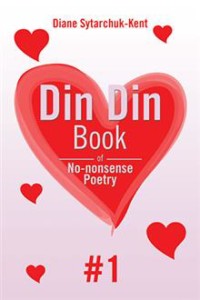Title: Din Din Book of No-nonsense Poetry #1
Author: Diane Sytarchuck-Kent
Publisher: Xlibris
ISBN: 978-1-49902-505-7
Pages: 682
Genre: Poetry/General
Reviewed by: Allison Walker
Buy on Amazon
Pacific Book Review Star
Awarded to Books of Excellent Merit

Poetry for children is a much-neglected genre. It seems to hover on two extremes: either complete fanciful nonsense, or watered down versions of adult poetry still too serious to be silly. Poet Diane Sytarchuck-Kent has found a happy medium, emphasis on happy. Her collection “Din Din Book of No-nonsense Poetry #1” is a book of “social stories” as told through rhyme, rhythm and meter.
Sytarchuck-Kent writes poems that aren’t supposed to always make linear sense. She creates poetry as it would be if everyone would stop taking themselves so seriously. Her poems are a celebration of rhyme and rhythm for the sake of sound; for the way rhymes feel rolling off your tongue to a swinging beat. For example, the piece “I’ll be here tomorrow” is full of contradictions. It leaps from thought to thought and away again. Its meter and rhyme are joyful and funny. It’s a poem that’s meant to be jigged to, and not read in serious contemplation. In addition, “Jamming with my buddies” is an encompassing example of what to expect from the collection. The poem is fun-filled and joyful, a poem to read to your children before bed so they dream of dancing.
In the midst of all this fun, Sytarchuck-Kent writes life lessons. For example, “Make today count” teaches us to chase after our dreams and find happiness, rather than wasting precious time playing spiteful games. Even “You can’t win them all,” which begins with pain and rejection, finishes in an uplifting tone, instructing us to pick ourselves up by the bootstraps if we have to.
Best of all, Sytarchuck-Kent has created exactly the right kind of illustrations to accompany her poems: whimsical and playful cartoons. The pictures jump about, some in linear order and others abandoned mid-leap to chase after some other adventure. They might crowd the margins telling their own story, or they might add some simple illustrations to compliment the words. As a reader, you can submerge as easily into the margins, following the cartoons around the edges of the page, as you do into the poems themselves, singing along to the words written across the center.
In a book of silly rhymes and dancing contradictions, one stands out. The poem “Ode to a verb” is different from the rest of the collection. It shows a deeper, more thoughtful poet, and a different woman than the writer of the others. Where the other poems are obvious in sharing the moral of their story, “Ode to a verb” is more leading and suggestive. It prompts contemplation.
Overall, Sytarchuck-Kent’s poetry is a collection of lovely, bouncing rhymes, playful and sweet. It is a book of poetry for children that is both laughter-inducing and full of life lessons.



Follow Us